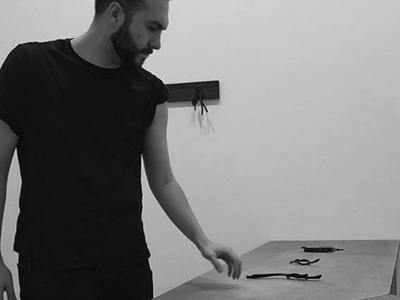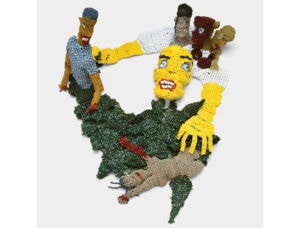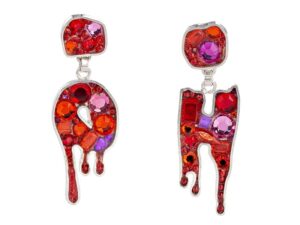Hearts + Flowers
September 16–November 12, 2021
In the Gallery at Brooklyn Metal Works, Brooklyn, NY, US
In Hearts + Flowers, jewelry and hand-held objects explore the topic or format of the souvenir in some way. The show started as an open call-for-entry curated by Jessica Andersen and Leslie Shershow. The exhibition is organized into loose and discrete categories. These order the pieces and construct connections between artistic practices. Visitors to the gallery are welcomed into an investigation of themes. The themes span collecting, heirlooms, the overlooked, markers of time, nostalgia, and the referential or personal object.
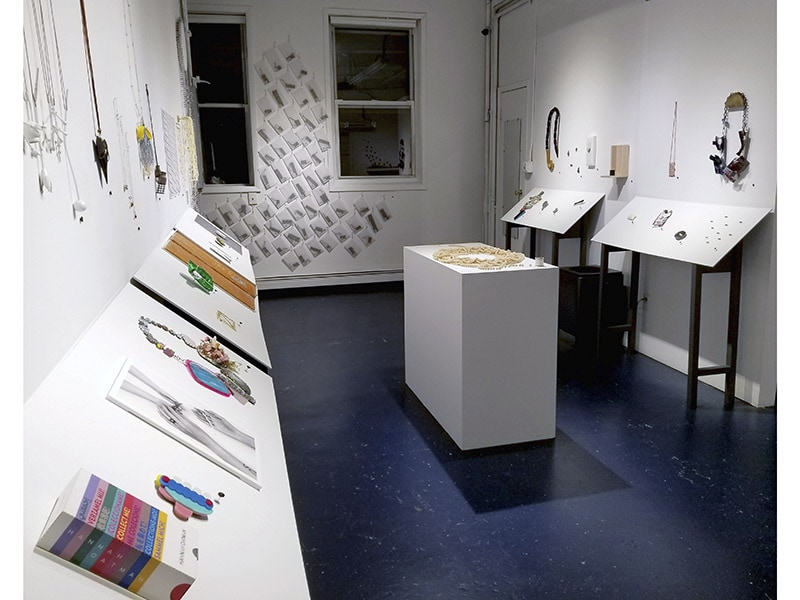
Upon entering the gallery, the visitor is greeted by pieces on angled shelves. Items are displayed along the gallery walls in a considered sequence. One first encounters Hannah Oatman’s Dreamboat. From the artist’s 2019 series Collect Me, this was originally sold as a collection of 50 blind-box packages. They debuted at New York City Jewelry Week 2019. The work prods at the core of what it means to collect. Collectors were allowed to purchase a boxed, unassembled brooch. Each box had specific odds of containing one of 10 brooch designs. These varied in complexity, material and artistic “value,” and scarcity.

Oatman’s acrylic and brass brooch, along with its custom, artist-made packaging, aptly begins the exhibition. Its invitation is not just to collect them all but rather to Collect Me! This sets a tone of personal investment. That is at the heart of the exhibition’s questions. Why do we collect? What souvenirs do we value? What do we deem worthy of holding on to? What drives our desire toward objects, places, and memories?
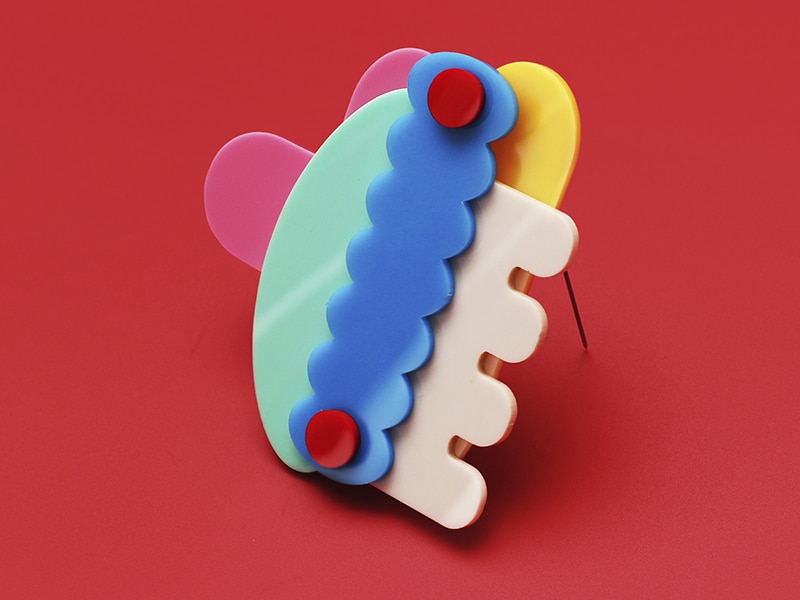
The visitor continues through the exhibition. Along the way, one encounters reflections on ubiquitous souvenir forms. There is Amelia Toelke’s Wish You Were Here brooch. It is gold plated and inspired by a postcard. Then there’s Sharon Massey’s larger-than-life shark-tooth-shaped Beachcomber necklace.
The visitor arrives at the work of MJ Tyson. Inheritance: Elana is a carefully amalgamated collection of keepsakes from one individual. Tyson has melted them down and poured them into an ingot-shaped necklace with an integrated ball chain. The work reforms accumulated objects into blocks of condensed sentiment and time, specially fit into a hand-made velvet jewelry box. There is deep care and consideration for the partially melted jewelry, integrated screws, or encased pewter-ware that make up the body of the pendant. It points to a future that we hope awaits our collected memories. A fate of being cared for, held onto, or even an allowance of a new life.
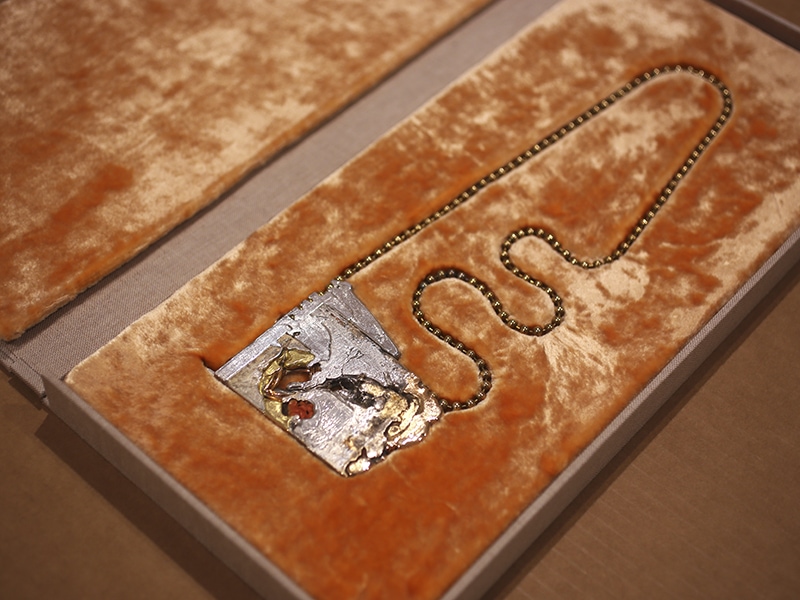
Souvenirs, just like the moments they are meant to preserve, amass. How they are acquired and how effectively they can hold onto the sentiments they contain is a topic of inquiry across the whole exhibition. Tyson’s Inheritance allows the potential difficulties that come with these questions to shift into focus.
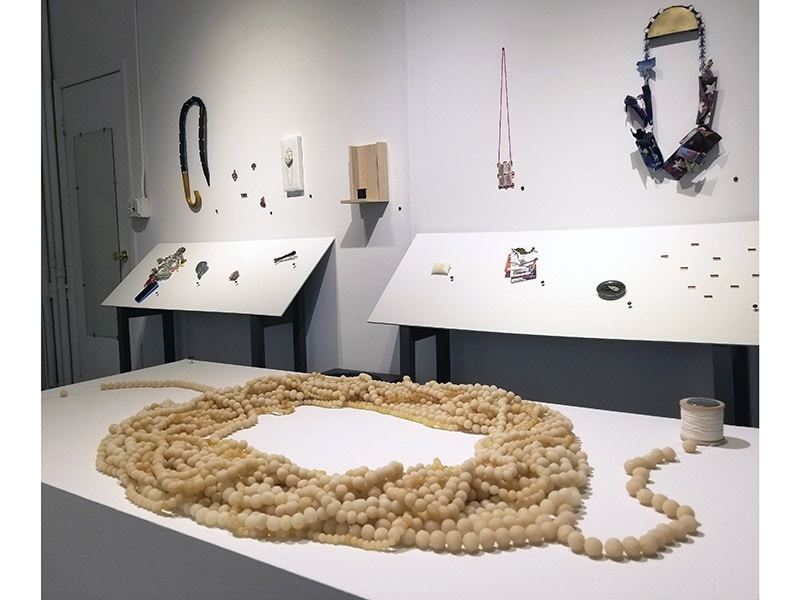
The tour through Hearts + Flowers continues. The focus of the work shifts from the recognizably grand to a celebration of more mundane encounters. There is collected detritus, as in the works of Violet Weiner and Shaunia Grant. Catalogs of time past up-end the conventional expectations of how value is constructed or what makes something worth the time and effort required in its collection. Work by Jolynn Santiago, Francine Grenci, and Kelly Ann Temple explore these themes.
Howard Street, by Valerie James, highlights the overlooked. A ghost-white brooch is superimposed onto a photograph. The Philadelphia artist’s work serves as a quiet yet powerful meditation on the lines and line breaks we pass over in our daily lives. It is made from a cast impression of a specific crack in the sidewalk on the artist’s daily commute.
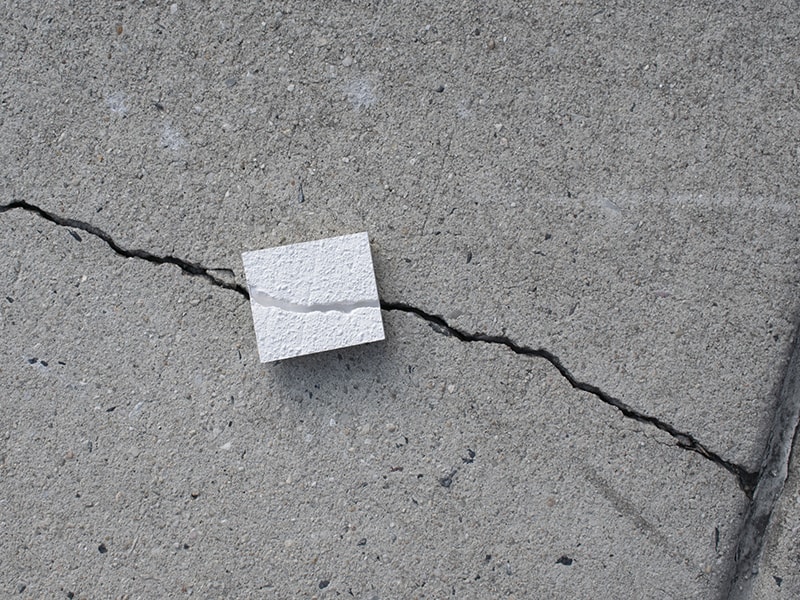
The brooch’s stark Hydrocal body is a near-perfect echo of the cement’s topography. By displaying the work on a to-scale image of its source, the curators have spotlighted how souvenirs often perform as snapshots—as fragments. James’s brooch is a fragment of a crack. The crack, in turn, is only a portion of a single paver in a sidewalk, which itself is only an element of the cityscape.
Souvenirs often require the potential of the fragment or symbol to recall a much broader environment or experience. Howard Street is a document of a crack, frozen in time and context. It is a document of what that found line was in the moment it was encountered, and taken from that context. In this way, the brooch performs much like an “I love New York” button, but in a much more sensitive and subtle way. It lets the wearer carry the memories and experiences associated with a specific time and space.
From fragments and quiet moments, the visitor is next confronted by another collection. The back wall of the gallery is covered in an installation by artist Beiya Yang. 100 I Love You is a grid of wearable, laser-cut paper tags. They are inside frosted envelopes stamped with printed QR codes. Scanning each envelope reveals its contents. It is the phrase “I Love You” translated in various languages. The words have been alpha-numerically coded into numerals. The viewer feels a momentary warmth. It quickly subsides as the digital coldness that brought those words onto the screen becomes clear.
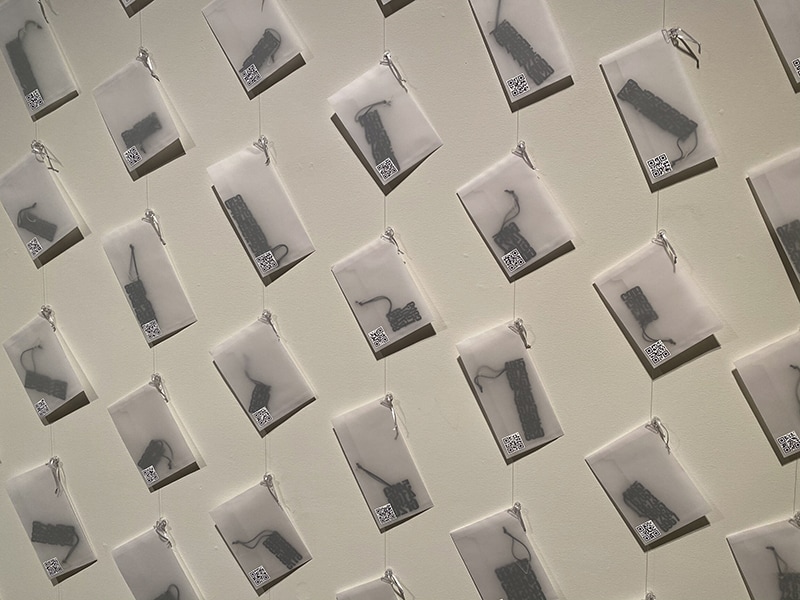
The work has a nearly sterile presentation of affection. This and the sheer number of envelopes reiterates the issues present in the formats of souvenirs. When repeated 100 times, do the words “I Love You” lose their weight? What about a postcard sent to 100 lovers? Or a button worn on 100 first dates? Contemporary souvenirs are often mass-produced trinkets. They are often made far from the places they mean to commemorate. Buyers often carry and wear them far away. Yang’s work plays beautifully on the line between the sincere desire to communicate affection and the manufactured existence of the tokens we collect.
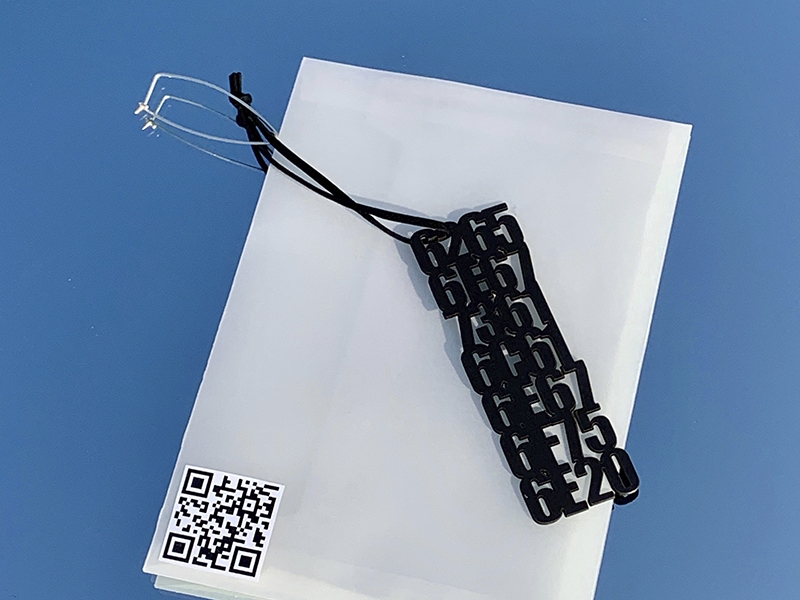
Along the final row of shelves, a collection of work speaks to specific memories of the artists and their individual lived experiences or identities. A small silver-lined brooch catches the eye. It serves as a catalyst of connection between the viewer and its maker. Neat as a Pin is by Funlola Coker. Shaped like a bobby-pin, the sterling silver brooch frames and neatly contains a collection of the artist’s hair. It is from the artist’s series To Grow You Is to Know You.

Histories of hair jewelry, mourning work, and fasteners are at play. But this piece is emphatically about the artist’s relationship to her own hair. In the exhibition catalog,[i] Coker writes:
Collect to hide
Collect to blend in
Collect to protect
Collect for shame
Collect for fear of being seen
Collect to understand …
Neat as a Pin explores the complex relationship Coker has to her own hair and the societal pressures and constructs that are built up to contain, control, and limit one’s personal or cultural expression. The work is an excellent example of the power and weight behind the objects that we carry with us, be it out of choice or compulsion.
A still-growing collaborative installation rounds out the exhibition. It is between artist Brice Garrett and attendees of his workshop, hosted at the exhibition. Workshop (2016–ongoing) presents as a wall piece. It is made of plaster pendants that Garrett casts into impressions made in clay by participants.
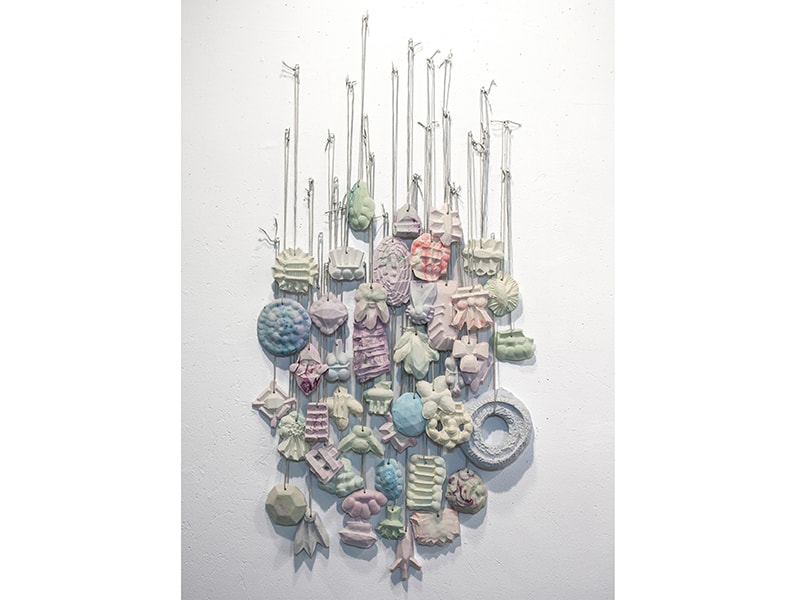
“Make your own” is a common marketing method used by gift shops. It builds an attachment between product and consumer. When you’ve invested your time and effort into creating something, it becomes valuable to you.
However, Garrett’s methodology is rooted more in conversation than consumer entrapment. Asking participants about specific jewelry memories or moments, Garrett invites a personal dialogue with each guest. The aim is to build a connection. The connection is not only between the artist and participant, but between the entire community that participates. It results in a wall of plaster portraits that grow in strength together.
Hearts + Flowers is a wonderful and intimate survey into the topic of souvenirs. The exhibition raises questions around our compulsion toward collecting. It asks how jewelry, as a format of expression, is best poised to explore them. This article is only a snapshot into the field of work in the exhibition. Thirty-eight artists’ practices make up Hearts + Flowers. It is impossible to explore the multiplicity of identities, depth of investigation, and individual personal narratives in one article, let alone one visit to the gallery. But the overwhelming nature of the show is one of its strongest points.
Hearts+Flowers was never about cliché symbols and quick reads. It is a thoughtful consideration on what it means to remember, misremember, and hold on. Like in the overflowing shelves of a souvenir kiosk, visitors will find something to connect with.
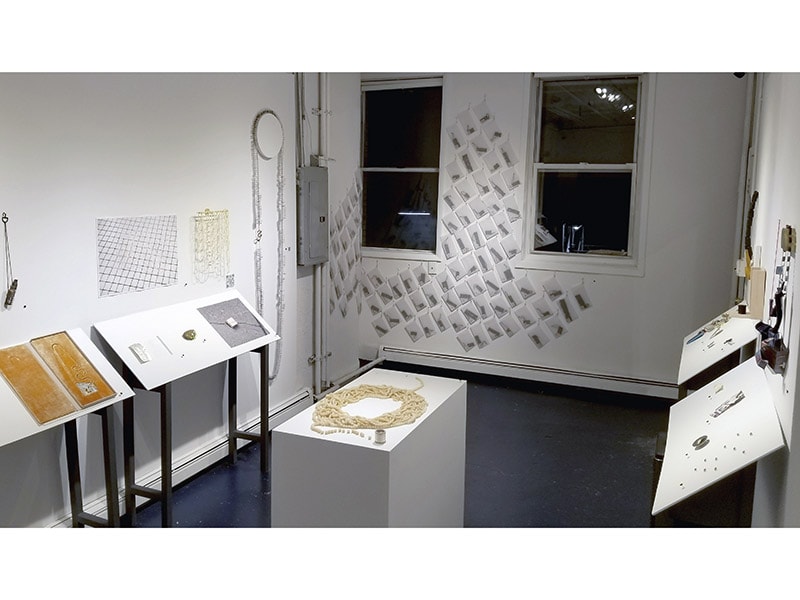
[i] It is available for reading while browsing the work.
